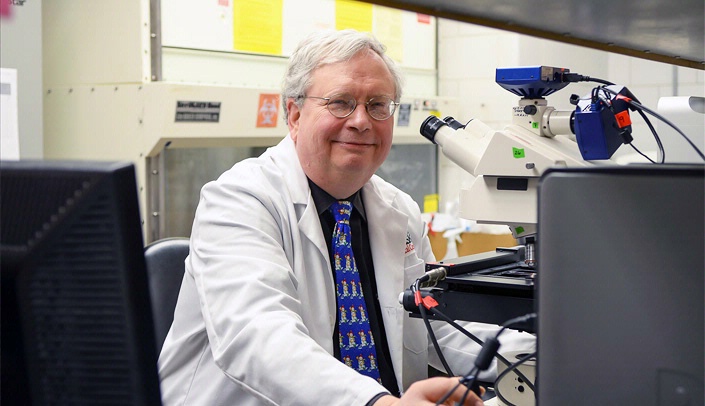A UNMC research team has been working on one phase of a concerted U.S. effort to develop a vaccine for the Ebola virus, which has infected more than 21,000 people in West Africa and killed more than 8,600 people.
James Talmadge, Ph.D., an immunologist and professor in the department of pathology and microbiology at UNMC, conducted a 10-month research project through the University of Nebraska’s National Strategic Research Institute (NSRI).
Dr. Talmadge’s five-member research team worked on this project on behalf of the Chemical Biological Medical Systems-Joint Vaccine Acquisition Program (CBMS-JVAP) as part of NSRI’s mission of providing research support for countering weapons of mass destruction (CWMD).
The CBMS-JVAP is the U.S. Department of Defense (DOD) organization responsible for developing, producing and stockpiling Food and Drug Administration (FDA)-licensed vaccine systems to protect soldiers from biological agents. Ebola is a class A bioterrorism agent with a mortality rate that can be as high as 90 percent.
Development of a medical countermeasure against the Ebola virus strains – Zaire, Sudan and Marburg – has become a DOD priority.
Several vaccine platforms are being developed and tested in rodents and primates. CBMS-JVAP has focused on an approach based on the use of FDA-approved aluminum salt (alum) adjuvants together with a virus-like particle (VLP) platform technology developed at the U.S. Army Medical Research Institute of Infectious Diseases (USAMRIID).
Dr. Talmadge said all vaccines that were studied by his team contained aluminum salt in them. The UNMC team was tasked with optimizing, characterizing and providing an initial assessment of the identified vaccine formulation.
This was successfully completed and provided significant insights into improved parameters for a filovirus vaccine and support for future developmental efforts.
“There are a number of different Ebola vaccines that are being developed,” Dr. Talmadge said. “Nobody can really say which ones will be functional in humans and primates. It’s too early to draw any final conclusions.
“We successfully completed our task and the information we gleaned now can be used by other research groups in the U.S. and hopefully will contribute to the ultimate development of an Ebola virus vaccine.”
The NSRI at the University of Nebraska is one of only 13 other University Affiliated Research Centers (UARC) established by Congress and administered by the Office of the Secretary of Defense.
Dr. Talmadge said the University of Nebraska has the only UARC in the country working on a vaccine for the Ebola virus.
“It speaks volumes that our university is involved in a project of world importance like this,” he said. “Ebola is a scary virus that is usually fatal within seven days after symptoms are expressed. With the potential for international transmission via air travel, it’s really important that we come up with a vaccine as soon as possible.”
The NSRI provides research and development services for the DOD and the U.S. Strategic Command in five core competencies that are critical to national security. Those core competencies are:
- Detection of chemical and biological weapons;
- Consequence management;
- Passive medical defense against weapons of mass destruction;
- Nuclear detection and forensics; and
- Space, cyber and telecom law.
“The U.S. Strategic Command and the University of Nebraska created the NSRI for this type of research – to find solutions to serious chemical, biological, radiological and nuclear threats,” said NSRI Executive Director Lt. Gen. (Ret.) Bob Hinson. “NSRI will continue to work with the nation’s Combating Weapons of Mass Destruction-focused agencies to conduct cutting-edge research to deal with threats like the Ebola virus.”
For Steve Callicutt, USSTRATCOM Director for Capability and Resource Integration, the work being done is all about making the world a more secure place.
“The U.S. Strategic Command is charged with combating weapons that present the gravest danger to the American public, namely weapons of mass destruction,” he said. “From sensing the threat to eliminating the materials, we face a challenge that is multidimensional and complex.
“We recognize this is a long-term problem that will require focused research, analysis, experimentation and testing. To that end, we established the UARC to build the body of knowledge this nation will need to maintain security both at home and abroad.”
Faculty members from across the university, including UNMC, have attracted more than $9 million in contract funding to pursue 22 different projects. The UNMC-affiliated investigators include:
- Steven Hinrichs, M.D., Stokes-Shackleford Professor of Pathology and Microbiology and department chairman, who coordinates the initiative’s core competency to detect chemical and biological weapons.
- Ken Bayles, Ph.D., professor of pathology and microbiology, who studies next-generation anthrax vaccines.
- James Talmadge, Ph.D., professor of pathology and microbiology, who works on strategies to better protect soldiers from biological weapons.
- Marilynn Larson, Ph.D., assistant professor of pathology and microbiology, who develops screening assays for the diagnosis of tularemia, which, due to its highly infectious nature and widespread distribution, has the potential for use as a biological weapon.
- Serguei Vinogradov, Ph.D., a research professor of pharmaceutical science, who researches better methods of detecting biological weapons so troops can more quickly protect themselves. In a related project, he explores the combination of commercial systems with systems still in the research phase to combat weapons of mass destruction.
- Tony Sambol, assistant professor of pathology and microbiology, who works to develop stronger processes to prevent, prepare for and respond to biological incidents that impact the Department of Defense.
